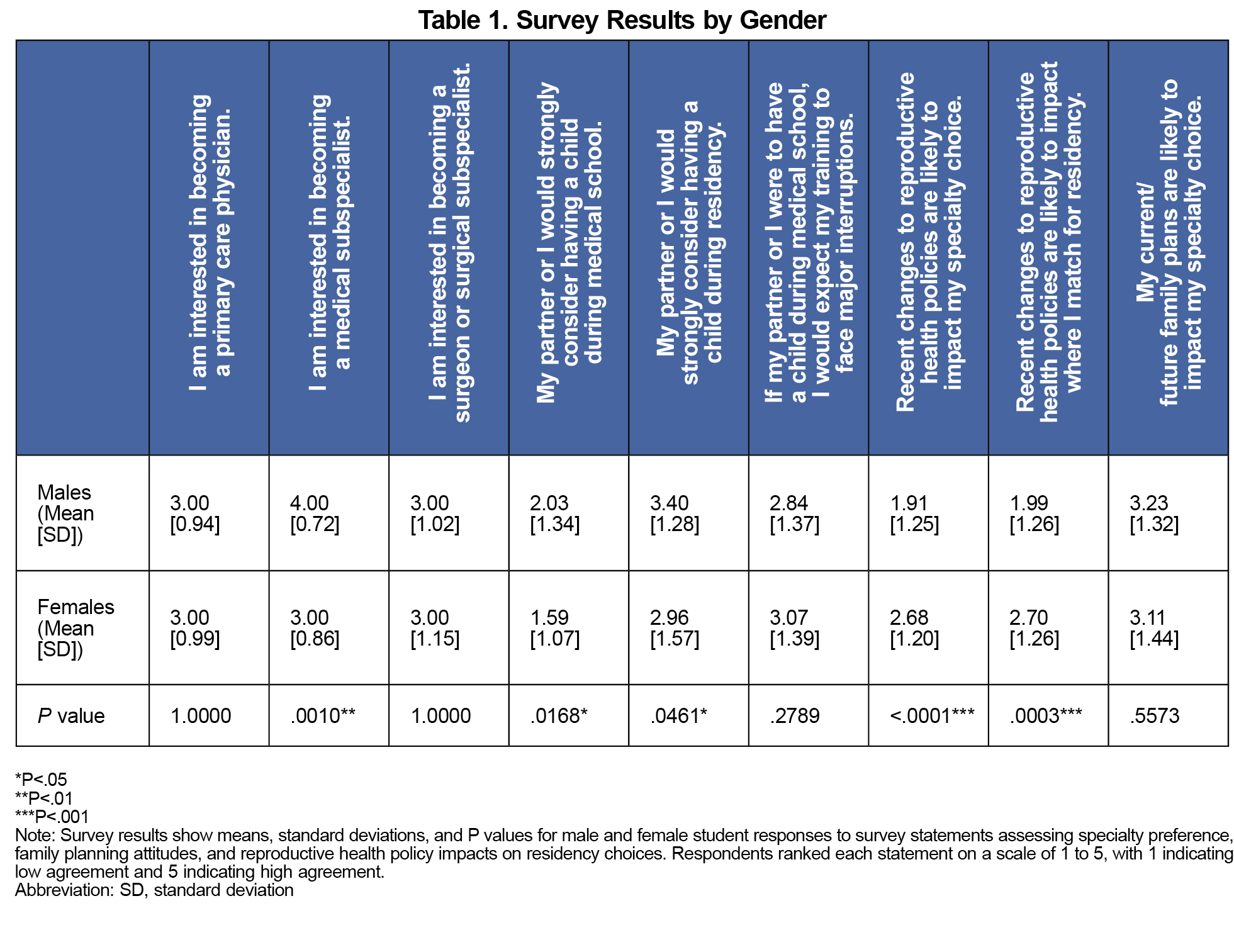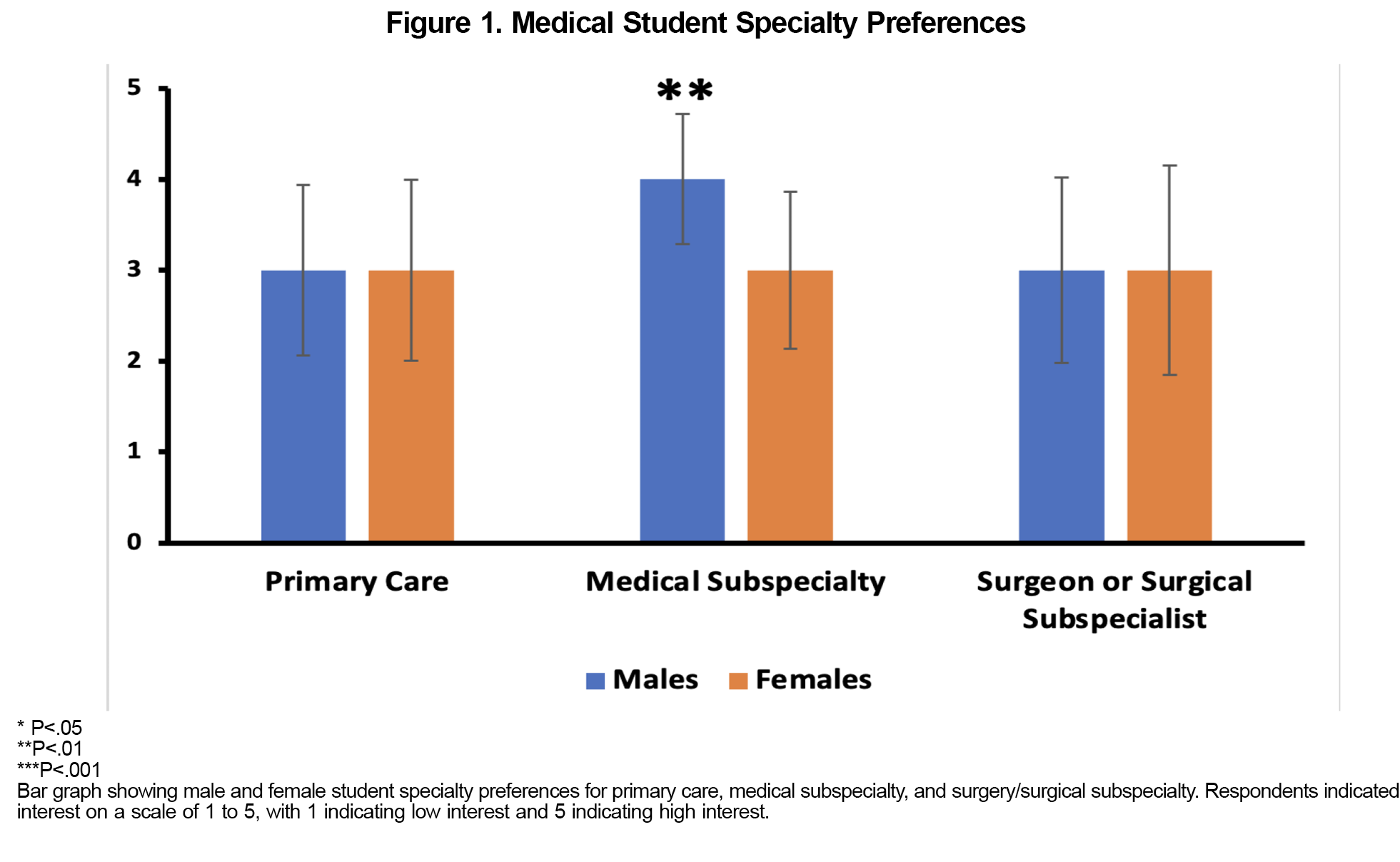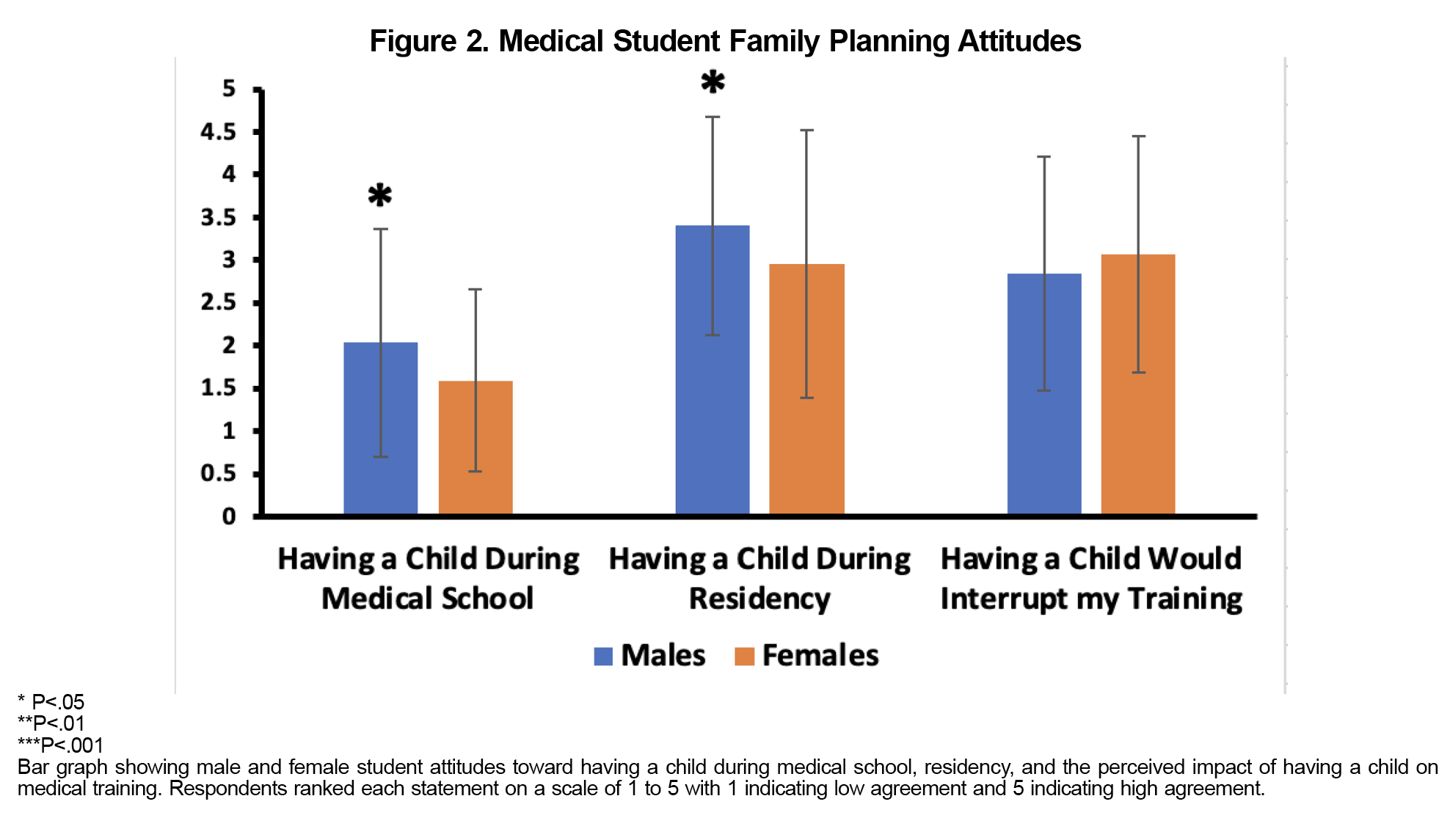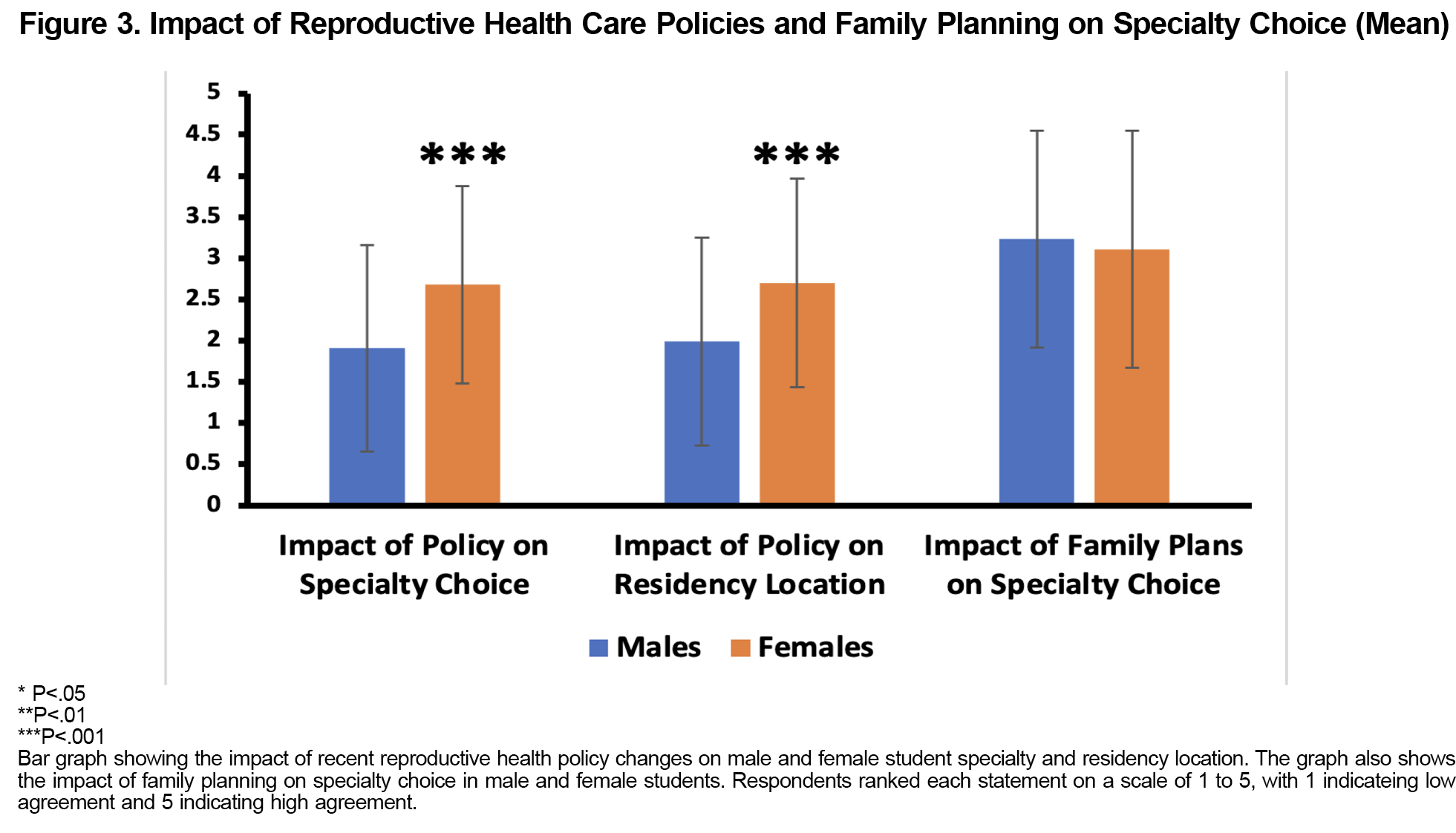Medical students’ career trajectories are shaped by the interplay of gender, family planning decisions, and external policy influences. One of the most significant career influences is the relationship between career demands and personal life decisions, particularly in the realm of family planning. Family planning during medical training is challenging, with commonly cited barriers, including limited time off, the demands of training, and the high cost of having a child.1 Reproductive health policy changes have further complicated these decisions. In a 2022 survey-based study of third- and fourth-year medical students, most respondents said changes in abortion access would likely or very likely influence their decision regarding where to start a family and desired residency match location. Cisgender females were more influenced by Dobbs v Jackson Women’s Health Organization regarding where and when to start a family.2 An Association of American Medical Colleges analysis found that residency programs in states with abortion bans have experienced ongoing declines in applicants during the 2 years after the Dobbs decision, particularly during the 2023–2024 application cycle.3 Furthermore, in the 2022–2023 application cycle, obstetrics and gynecology residency programs in states with restrictive abortion policies saw fewer unique applicants compared to programs in states without such restrictions.4 However, these studies examined only third- and fourth-year medical students. Our study aimed to examine gender differences among first-year medical students in their specialty choices, family planning decisions, and the effects of recent reproductive health policy changes on specialty choice and preferred residency match locations. Insights into gender differences among medical students can help educators provide informed career guidance to ensure that students are making choices aligned with their interests and values.
LEARNER RESEARCH
Influence of Reproductive Health Policy on West Texas Medical Students’ Specialty and Residency Choices
Sachi Khemka, MBA, BS | Merry Mathew, BS | Betsy Jones, EdD
PRiMER. 2025;9:12.
Published: 4/4/2025 | DOI: 10.22454/PRiMER.2025.512781
Introduction: Gender-based differences in medical student preferences are of growing interest. This study examines specialty choice and family planning preferences among medical students in Lubbock, Texas. It also assesses the impact of reproductive health policy changes on specialty choice and desired residency location.
Methods: A Qualtrics (Silver Lake) survey was sent to 172 first-year medical students from Texas Tech University Health Sciences Center (TTUHSC) School of Medicine. Males’ responses were compared with females’ responses using an unpaired t test with a significance threshold of 0.05.
Results: Surveys were returned by 90 male and 82 female participants. Results show that both genders exhibited moderate interest in primary care and surgical specialties, with males showing higher interest in becoming medical subspecialists (P=.0010). Female participants were less inclined than males to consider having a child during medical school (P=.0168) and residency (P=.0461). Males expressed lower concern than females about reproductive health policy impacts on specialty choice (P<.0001) and preferred residency location (P=.0003). Family planning considerations were equally moderate in impacting specialty choice for both genders.
Conclusions: The findings indicate that male students are more open to the idea of having a child during training and that reproductive health policy changes have had a larger influence on female students’ specialty choice and desired match location. To support physicians-in-training, educators should integrate family planning discussions, prioritize reproductive health education, advocate for and improve residency transparency on parental leave policies, and help students navigate residency applications amid policy changes.
This study was granted exemption by the Institutional Review Board at Texas Tech University Health Sciences Center (TTUHSC), because it was determined to pose minimal risk to participants. The survey was administered to 90 male and 82 female first-year medical students at TTUHSC in September 2023 as part of a larger mandatory curriculum survey using the Qualtrics (Silver Lake) platform. The survey is available from the STFM Resource Library.5 Participants rated their level of agreement with nine distinct statements, ranking each statement on a scale of 1 to 5, with 1 indicating low agreement and 5 indicating high agreement. We compared the means between males’ and females’ responses to each statement and conducted an unpaired t test to see whether differences in means were statistically significant using a significance threshold of P<.05. We analyzed data using Microsoft Excel (Microsoft Corp). Our survey sample included the entire first-year class of the TTUHSC School of Medicine, ensuring a diverse and representative sample. Mean values between 1.00 and 2.50 were considered low agreement, those between 2.50 and 3.50 were considered moderate agreement, and those between 3.50 and 5.00 were considered high agreement.
Our survey had a 100% response rate because it was part of a mandatory survey. All questions were answered by all participants. Respondents were provided with a third option for gender, allowing them to write in their own response if they did not identify as female or male. None of the respondents used this option. Means, standard deviations, and P values for each survey statement are reported in Table 1. Gender demographic data at TTUHSC, Texas medical schools, and US medical schools are provided in Table 2.6
Specialty Interest Levels
Both male and female medical students expressed a moderate level of interest in pursuing primary care specialties and surgical subspecialties, with no significant difference between the two groups. However, we found a significant difference between the two groups toward becoming medical subspecialists (Figure 1).
Family Planning During Medical School and Residency
During medical school, both male and female students expressed a low inclination to consider having a child, but female participants demonstrated a significantly lower inclination than male participants. During residency, both male and female medical students exhibited a moderate inclination to consider having a child, but female participants demonstrated a significantly lower inclination than male participants (Figure 2).
Impact of Reproductive Health Policy Changes on Specialty Choice and Desired Residency Location
Male participants exhibited low concern regarding recent reproductive health policy changes impacting their specialty choice, while female participants exhibited moderate concern. Similarly, males expressed low concern about reproductive health policy changes affecting their preferred residency location, while females expressed moderate concern. Male students expressed significantly lower concern about recent reproductive health policy changes impacting specialty choice and preferred residency location compared to female students (Figure 3).
In our study, males and females showed equal preference toward surgical subspecialties, an unexpected finding because prior studies have reported that males tend to prefer surgical subspecialties.7,8 Our study also showed that males were significantly more open to having a child during medical training. A possible interpretation of this finding is that females are more likely to face challenges related to pregnancy and family planning during training, with one study finding that three-fourths of female physicians choose to delay childbearing. Reasons for delay in this study included limited schedule flexibility, time constraints, stress, financial strain, and the concern of burdening colleagues.9 Another study found that female residents are delaying childbearing due to a busy work schedule, a desire not to extend residency training, a lack of access to childcare, financial concerns, fear of burdening colleagues, and worries about pregnancy complications.10 In contrast, males may not face these challenges to the same extent. Incorporating family planning discussions in medical education, executing policies supporting parental leave in residency, and improving residency program transparency on parental leave policies, childcare options, and family-building support are essential steps forward.11 Additionally, in our study, reproductive health policy changes had a greater impact on female medical students’ future specialty choice and desired match location. This finding aligns with prior research showing that abortion access significantly influences residency decisions, particularly among cisgender females, and with data from the 2022–2023 cycle reporting fewer applicants to obstetrics and gynecology programs in states with abortion restrictions.2-4
Our findings imply that reproductive health policy changes can impact where future female physicians choose to practice and may deter them from certain specialties. The South and Midwest contain many states with restrictive abortion policies.12 These regions are also more likely to face limited geographic access to maternity care;13 our findings suggest that these policies could exacerbate health care workforce shortages in these states if female students opt not to pursue residency there. Educators should prioritize reproductive health education, facilitate out-of-state training opportunities, and provide counseling on navigating residency applications in light of policy changes. Overall, this study highlighted gender-based differences in family planning decisions and the influence of reproductive health policies on medical students’ career choices. Methodological weaknesses of the study included the reliance on self-reported data, which could introduce bias. The generalizability of these findings and the sample size of our study were limited due to our single-institution design. The absence of responses from nonbinary participants limited the inclusivity of our research. Future research could mitigate these limitations by incorporating objective measures alongside self-reported data, including multiple institutions for broader generalizability, and exploring longitudinal outcomes and diverse gender perspectives.
Acknowledgments
*Authorship Note: Merry Mathew and Sachi Khemka contributed equally to this paper and should be considered co-first authors.
Presentations: Preliminary results for this manuscript were presented at the American Medical Women’s Association 109th Annual National Conference, March 22, 2024, Virtual Conference.
References
- Vestal N, Hunt KN, Levy MS, et al. Family planning, fertility, and medical school: a survey of students’ plans and perceptions of institutional support. Perm J. 2023;27(3):37-48. doi:10.7812/TPP/23.003
- Mermin-Bunnell K, Traub AM, Wang K, Aaron B, King LP, Kawwass J. Abortion restrictions and medical residency applications. J Med Ethics. 2025;51:79-86. doi:10.1136/jme-2023-109190
- Orgera K, Grover A. States with abortion bans see continued decrease in U.S. MD senior residency applicants. Association of American Medical Colleges, Research and Action Institute; May 9, 2024. https://www.aamcresearchinstitute.org/our-work/data-snapshot/post-dobbs-2024
- Hammoud MM, Morgan HK, George K, et al. Trends in obstetrics and gynecology residency applications in the year after abortion access changes. JAMA Netw Open. 2024;7(2):e2355017. doi:10.1001/jamanetworkopen.2023.55017
- Mathew M, Khemka S, Jones B. TTUHSC medical school student survey. Society of Teachers of Family Medicine Resource Library; 2024. https://resourcelibrary.stfm.org/viewdocument/appendixttuhsc-medical-school-stud?CommunityKey=2751b51d-483f-45e2-81de-4faced0a290a&tab=librarydocuments
- Association of American Medical Colleges. Total enrollment by U.S. MD-granting medical school and gender, 2019-2020 through 2023-2024. AAMC; November 6, 2023. Accessed January 20, 2025. https://www.aamc.org/media/6101/download
- LeMarbe KE, Elassar H, Ibrahim Y, Roach VA, Taylor TAH. Bridging the gap: gender differences in medical student career motivators and their influence on surgical specialty interest. Intl J Surgical Education.Accessed January 20, 2024. do:10.5281/zenodo.14838375
- Association of American Medical Colleges. Table B3. number of active residents, by type of medical school, GME specialty, and gender. Accessed September 16, 2024. https://www.aamc.org/data-reports/students-residents/data/report-residents/2023/table-b3-number-active-residents-type-medical-school-gme-specialty-and-gender
- Bakkensen JB, Smith KS, Cheung EO, et al. Childbearing, infertility, and career trajectories among women in medicine. JAMA Netw Open. 2023;6(7):e2326192. doi:10.1001/jamanetworkopen.2023.26192
- Stack SW, Jagsi R, Biermann JS, et al. Childbearing decisions in residency: a multicenter survey of female residents. Acad Med. 2020;95(10):1,550-1,557. doi:10.1097/ACM.0000000000003549
- Dason ES, Maxim M, Gesink D, et al. Medical students’ perspectives on family planning and impact on specialty choice. JAMA Surg. 2024;159(2):170-178. doi:10.1001/jamasurg.2023.6392
- Guttmacher. Interactive map: US abortion policies and access after Roe. Accessed January 20, 2025. https://states.guttmacher.org/policies/?gad_source=1&gclid=Cj0KCQiA4rK8BhD7ARIsAFe5LXL9x2nGmo1sZe7IQBFN-dJtIas7jwyONkHiNcumEBHS8IwRJ1A3vqwaAlIcEALw_wcB
- March of Dimes. Nowhere to Go: Maternity Care Deserts Across the US 2024 Report. Accessed January 20, 2025. https://www.marchofdimes.org/maternity-care-deserts-report
Lead Author
Sachi Khemka, MBA, BS
Affiliations: Texas Tech University Health Sciences Center School of Medicine, Lubbock, TX
Co-Authors
Merry Mathew, BS - Texas Tech University Health Sciences Center School of Medicine, Lubbock, TX
Betsy Jones, EdD - Department of Medical Education, Texas Tech University Health Sciences Center, Lubbock, TX
Corresponding Author
Sachi Khemka, MBA, BS
Correspondence: Texas Tech University Health Sciences Center School of Medicine, Lubbock, TX
Email: sachi.khemka@ttuhsc.edu
Fetching other articles... 
Loading the comment form... 
Submitting your comment... 







There are no comments for this article.